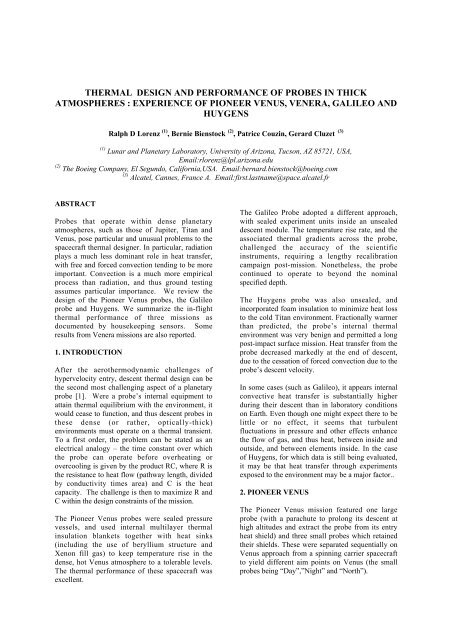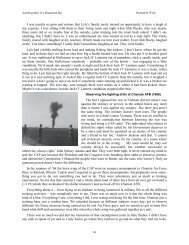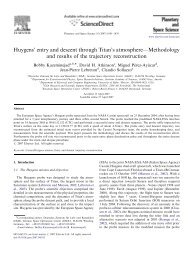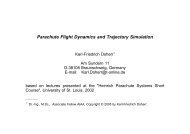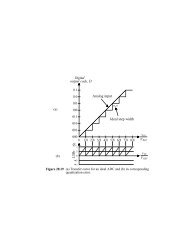THERMAL DESIGN AND PERFORMANCE OF PROBES IN THICK ...
THERMAL DESIGN AND PERFORMANCE OF PROBES IN THICK ...
THERMAL DESIGN AND PERFORMANCE OF PROBES IN THICK ...
You also want an ePaper? Increase the reach of your titles
YUMPU automatically turns print PDFs into web optimized ePapers that Google loves.
<strong>THERMAL</strong> <strong>DESIGN</strong> <strong>AND</strong> <strong>PERFORMANCE</strong> <strong>OF</strong> <strong>PROBES</strong> <strong>IN</strong> <strong>THICK</strong><br />
ATMOSPHERES : EXPERIENCE <strong>OF</strong> PIONEER VENUS, VENERA, GALILEO <strong>AND</strong><br />
HUYGENS<br />
Ralph D Lorenz (1) , Bernie Bienstock (2) , Patrice Couzin, Gerard Cluzet (3)<br />
(1) Lunar and Planetary Laboratory, University of Arizona, Tucson, AZ 85721, USA,<br />
Email:rlorenz@lpl.arizona.edu<br />
(2) The Boeing Company, El Segundo, California,USA. Email:bernard.bienstock@boeing.com<br />
(3) Alcatel, Cannes, France A. Email:first.lastname@space.alcatel.fr<br />
ABSTRACT<br />
Probes that operate within dense planetary<br />
atmospheres, such as those of Jupiter, Titan and<br />
Venus, pose particular and unusual problems to the<br />
spacecraft thermal designer. In particular, radiation<br />
plays a much less dominant role in heat transfer,<br />
with free and forced convection tending to be more<br />
important. Convection is a much more empirical<br />
process than radiation, and thus ground testing<br />
assumes particular importance. We review the<br />
design of the Pioneer Venus probes, the Galileo<br />
probe and Huygens. We summarize the in-flight<br />
thermal performance of three missions as<br />
documented by housekeeping sensors. Some<br />
results from Venera missions are also reported.<br />
1. <strong>IN</strong>TRODUCTION<br />
After the aerothermodynamic challenges of<br />
hypervelocity entry, descent thermal design can be<br />
the second most challenging aspect of a planetary<br />
probe [1]. Were a probe’s internal equipment to<br />
attain thermal equilibrium with the environment, it<br />
would cease to function, and thus descent probes in<br />
these dense (or rather, optically-thick)<br />
environments must operate on a thermal transient.<br />
To a first order, the problem can be stated as an<br />
electrical analogy – the time constant over which<br />
the probe can operate before overheating or<br />
overcooling is given by the product RC, where R is<br />
the resistance to heat flow (pathway length, divided<br />
by conductivity times area) and C is the heat<br />
capacity. The challenge is then to maximize R and<br />
C within the design constraints of the mission.<br />
The Pioneer Venus probes were sealed pressure<br />
vessels, and used internal multilayer thermal<br />
insulation blankets together with heat sinks<br />
(including the use of beryllium structure and<br />
Xenon fill gas) to keep temperature rise in the<br />
dense, hot Venus atmosphere to a tolerable levels.<br />
The thermal performance of these spacecraft was<br />
excellent.<br />
The Galileo Probe adopted a different approach,<br />
with sealed experiment units inside an unsealed<br />
descent module. The temperature rise rate, and the<br />
associated thermal gradients across the probe,<br />
challenged the accuracy of the scientific<br />
instruments, requiring a lengthy recalibration<br />
campaign post-mission. Nonetheless, the probe<br />
continued to operate to beyond the nominal<br />
specified depth.<br />
The Huygens probe was also unsealed, and<br />
incorporated foam insulation to minimize heat loss<br />
to the cold Titan environment. Fractionally warmer<br />
than predicted, the probe’s internal thermal<br />
environment was very benign and permitted a long<br />
post-impact surface mission. Heat transfer from the<br />
probe decreased markedly at the end of descent,<br />
due to the cessation of forced convection due to the<br />
probe’s descent velocity.<br />
In some cases (such as Galileo), it appears internal<br />
convective heat transfer is substantially higher<br />
during their descent than in laboratory conditions<br />
on Earth. Even though one might expect there to be<br />
little or no effect, it seems that turbulent<br />
fluctuations in pressure and other effects enhance<br />
the flow of gas, and thus heat, between inside and<br />
outside, and between elements inside. In the case<br />
of Huygens, for which data is still being evaluated,<br />
it may be that heat transfer through experiments<br />
exposed to the environment may be a major factor..<br />
2. PIONEER VENUS<br />
The Pioneer Venus mission featured one large<br />
probe (with a parachute to prolong its descent at<br />
high altitudes and extract the probe from its entry<br />
heat shield) and three small probes which retained<br />
their shields. These were separated sequentially on<br />
Venus approach from a spinning carrier spacecraft<br />
to yield different aim points on Venus (the small<br />
probes being “Day”,”Night” and “North”).
The overall design of the Pioneer Venus probes is<br />
described in [1] and [2]. The thermal design of the<br />
large probe is discussed in some detail in [3].<br />
In brief, the interior of the large probe pressure<br />
vessel was lined with 41 layers of aluminized<br />
Kapton MLI to act as a barrier to radiation and<br />
convection. Structural penetrations of the blanket<br />
were made with Titanium to minimize conductive<br />
shorts. These features increased ‘R’. The ‘C’ term<br />
in the equation was maximized by using beryllium<br />
for the equipment shelves. This metal, although<br />
difficult to work with, has a heat capacity of some<br />
2000 J/kgK – double that of Aluminium.<br />
The MLI performance was tested with a nitrogen<br />
atmosphere, and with nitrogen+helium (since one<br />
of the experiments vented helium into the probe<br />
during descent.) This allowed the analytical<br />
thermal model to be updated, since the<br />
conductivity of helium is much higher than<br />
nitrogen by a known factor. Other tests showed<br />
free convection heat transfer coefficients for<br />
internal surfaces of 0.5 to 2 BT/hr-ft2-F<br />
The destructive effects of physical simulation to<br />
the full 900F made it necessary to limit tests to<br />
500F : when that temperature was reached the test<br />
was prolonged to permit internal temperatures to<br />
rise to the levels expected during the real descent.<br />
A thermal test model (TTM) was used for initial<br />
design verification. Note that because of the<br />
thermal sealing, electrical tests of the probe were<br />
limited to less than 2 hours [2] except when special<br />
cold nitrogen cooling was used.<br />
During a descent test on the flight unit, some of the<br />
internal heat transfer was found to be lower than<br />
the TTM or analysis suggested. One factor was<br />
believed to be the role of the cable harness in<br />
impeding gas flow [3].<br />
Flight temperature data and the predictions are<br />
shown in figure 1. Data – previously unpublished –<br />
are taken from [4]. Plots are referred to time of<br />
first loss of signal – data were sent prior to the<br />
short entry phase, during which time the plasma<br />
sheath caused a radio blackout. This forms the time<br />
reference.<br />
The three small probes clearly had a higher<br />
area:volume ratio. Accordingly, they needed<br />
thicker thermal blankets (61 layers). On both large<br />
and small probes the MLI blankets were held in<br />
place against the high entry g-loads by Titanium<br />
retainers. A second measure to decrease the<br />
internal heat transfer was the substitution of Xenon<br />
for nitrogen as the fill gas.<br />
Figure 1. PV large probe temperature history for<br />
the forward and aft shelves. Solid line are actuals –<br />
dashed are predictions. The probe started off<br />
slightly warmer than predicted (see Huygens later)<br />
but the temperature rise was slightly lower than<br />
expected.<br />
Xenon, with a high relative molecular mass, has a<br />
low thermal conductivity. (Its breakdown potential<br />
is quite low, which would be problematic for the<br />
high voltages associated with the large probe’s<br />
neutral mass spectrometer : the large probe retained<br />
nitrogen as the fill gas.)<br />
Figure 2. Small probe 2 (day probe) temperature<br />
history – the probe failed an hour after impact,<br />
with temperatures at 115 and 70C.<br />
The pressure inside all of the probes increased<br />
during their missions. The temperature rise of the<br />
gas, were it at the shelf temperature, would account<br />
for an ideal-gas pressure rise of only ~10-25%. The<br />
increase of ~50% implies the gas itself was<br />
considerably hotter than the shelf (as expected)<br />
although possible outgassing from materials (e.g.<br />
mylar may lose ~2% by mass as water) or small<br />
leaks may have also been a factor.
Figure 3. Internal pressure histories of the probes.<br />
It is notable that small probe 2 (the Day probe)<br />
survived for some 70 minutes after landing. As the<br />
probe internal temperature increased, the battery<br />
voltage rose to 30.8 Volts. However, the current<br />
consumed dropped, together with the signal<br />
strength of the signal received on Earth, suggesting<br />
that a power amplifier component failed [2].<br />
Figure 4. Voltage/Current history of the day<br />
probe, suggesting transmitter failure as ‘cause of<br />
death’.<br />
3. VENERA<br />
The Russian Venus probes faced the same design<br />
challenges (indeed, more severe ones, since<br />
operation after impact was desired).<br />
The Veneras [5] incorporated insulation both<br />
internal and external to the pressure vessel, and<br />
phase change materials (lithium nitrate trihydrate)<br />
to further buffer the temperatures, especially<br />
adjacent to units with high power dissipation.<br />
A fan maintained circulation of the air inside the<br />
pressure vessel to ensure even distribution of<br />
temperature and the efficient function of the phasechange<br />
heat sink.<br />
The insulation used on the exterior was a bonded<br />
porous silica material (which would remain rigid,<br />
and insulating, in the face of mechanical loads<br />
during entry and descent). A special coating<br />
(presumably something like a sealant) was applied<br />
to minimize the effect of ventilating the insulation<br />
during the descent.<br />
The density of the Venus atmosphere, together<br />
with the earth-like gravity, leads to fairly high<br />
Reynolds numbers during descent. Heat transfer<br />
coefficients were therefore very high, of the order<br />
150-1000 Wm -2 K -1 and the temperature of the<br />
probe surface was therefore almost exactly the<br />
same as the ambient air.<br />
As can be seen from fig.5 , the internal temperature<br />
fell well within the region expected from ground<br />
testing.<br />
Figure 5. Venera 14 internal temperature history.<br />
The designers note [5[ that towards the end of the<br />
probe’s operational life on the surface, the<br />
temperatures in the upper hemisphere of the<br />
pressure vessel exceeded those in the lower<br />
hemisphere by some 70-100 o C. Also, in the<br />
‘scientific apparatus container’ (which did not have<br />
forced ventilation by a fan) some hotspots<br />
developed : some hotspots also formed in the<br />
instrument container where structural components<br />
required the insulation to be thinner than elsewhere<br />
– these spots were 20-35 o C warmer than their<br />
surrounds.<br />
4. GALILEO<br />
The Galileo probe, although owing considerable<br />
heritage to the Pioneer Venus experience, adopted<br />
a different thermal design approach : rather than<br />
build a probe that is a pressure vessel, the probe<br />
itself was open, and individual equipment boxes<br />
were sealed. A brief review of the probe design is<br />
given in [1].
Scaling of pressure forces suggests this approach<br />
has some design merit – smaller boxes of a given<br />
wall thickness can withstand higher pressures. It<br />
also conveniently transfers the problem of<br />
sampling aperture and window design (a major<br />
challenge in Pioneer Venus, which needed sapphire<br />
and diamond windows) from the probe contractor<br />
to the individual experimenters. Note also that the<br />
Galileo probe did not have to endure pressures<br />
nearly as high as Pioneer Venus.<br />
Some of the thermal testing associated with<br />
Galileo, as well as a somewhat obscure heating<br />
effect (namely heating by adiabatic compression,<br />
as air progressively leaks into the probe volume<br />
and raises its pressure) are described in [6].<br />
Additional discussion of testing and flight<br />
performance is presented in [7].<br />
Some Galileo Probe housekeeping temperatures are<br />
available on the Planetary Data System (PDS) via<br />
the Atmospheric Structure Instrument [8,9]. The<br />
relevant data product is ASI.PDS.F.HK.02 and are<br />
plotted in figure 6 at the end of this paper.<br />
The temperature labelled ‘Taero’ is from a<br />
temperature sensor mounted on the inside of the<br />
Descent Module outer skin. This was to provide<br />
some sort of back-up to the ASI atmospheric<br />
temperature sensors : it followed the ASI sensors<br />
with a lag of ~ 1minute or
ack of the heat shield which was illuminated<br />
during the coast.<br />
Cooling by forced convection increased<br />
progressively during descent as the air becomes<br />
denser. After landing, the heat loss from the probe<br />
slows appreciably, allowing a constraint to be<br />
derived on near-surface windspeeds [12].<br />
There is some evidence that the heat leak through<br />
some experiments was higher than budgeted.<br />
Forced convection effects not reproduced in<br />
ground tests may be responsible, although the net<br />
impact was not significant.<br />
6. DISCUSSION - COMMON THEMES<br />
An exotic arsenal of techniques have been applied<br />
in thermal management of probes, including use of<br />
beryllium, phase change materials and a variety of<br />
insulation types. Although in retrospect some<br />
thermal designs could have been improved (e.g.<br />
Galileo) they have generally met all requirements.<br />
One striking, but not widely-reported, finding<br />
herein is that convective heat transfer inside vented<br />
probes is often substantially higher during their<br />
descent than in laboratory conditions on Earth.<br />
Even though one might expect there to be little or<br />
no effect, it seems that turbulent fluctuations in<br />
pressure and other effects enhance the flow of gas,<br />
and thus heat, between inside and outside, and<br />
between elements inside.<br />
This and the other difficulties of thermal design<br />
underscore the difficulty and importance of thermal<br />
testing. Probes are engineering experiments as well<br />
as scientific platforms.<br />
7. ACKNOWLEDGEMENTS<br />
RDL acknowledges the support of the Cassini<br />
project, and the assistance of Helen Fan in<br />
digitizing and plotting archive data. We appreciate<br />
the comments of Lee Hennis.<br />
8. REFERENCES<br />
1. Bienstock, B., Pioneer Venus and Galileo Entry<br />
Probe Heritage, Proceedings of the International<br />
Workshop “Planetary Probe Atmospheric Entry<br />
and Descent Trajectory Analysis and Science”<br />
Lisbon, Portugal 6-9 October 2003, ESA SP-544,<br />
February 2004 pp.37-45<br />
2. R. F. Brodsky (ed), Pioneer Venus Case Study in<br />
Spacecraft Design, AIAA Professional Study<br />
Series, 1979<br />
3. L. A. Hennis and M. N. Varon, , Thermal<br />
Design and Development of the Pioneer Venus<br />
Large Probe, in Thermophysics and Thermal<br />
Control (R. Visjanta, ed) Vol.65 of Progress in<br />
Astronautics and Aeronautics, AIAA (Presented as<br />
Paper 78-916 at the 2 nd AIAA/ASME<br />
Thermophysics and Heat Transfer Conference,<br />
Palo Alto, California, May 24-26, 1978)<br />
4. C. M. Meredith, A Not-So-Quick Look at the<br />
Probes Descent Data, Hughes Aircraft Corporation<br />
Interdepartmental Correspondence HS507-7982,<br />
16 January 1979.<br />
5. I. A. Zelenov, A. F. Klishin, V. M. Kovtunenko<br />
and A. F. Shabarchin, Methods of Providing for<br />
Thermal Conditions in teh Venera Automatic<br />
Interplanetary Stations when in the Atmosphere of<br />
Venus, Kosmicheskie Issledovania, 26, 33-36, Jan-<br />
Feb 1988.<br />
[6] R P Bobco, Free Convection in Enclosures<br />
Exposed to Compressive Heating, AIAA-80-1536,<br />
AIAA 15 th Thermophysics Conference, July 14-16,<br />
Snowmass, CO, 1980<br />
7. Hughes Aircraft Corporation, Galileo Mission<br />
Operations Final Report, 1996<br />
8. Seiff, A.and Knight, T.C.D.: 1992, The Galileo<br />
probe atmosphere structure instrument, Space<br />
Science Reviews, 60, 203.<br />
9. Seiff, A., et al. 1998, Thermal Structure of<br />
Jupiter's atmosphere near the edge of a 5 micrometre<br />
hot spot in the north equatorial bellt, J.<br />
Geophys. Res., 103, 22,857.<br />
10. J. Doenecke, M. Elsner, Special Heat Transfer<br />
Problems within the Huygens Probe, Proceedings,<br />
4th European Symposium on Space Environmental<br />
Control Systems, pp. 279-283<br />
11. Jones J C and F Giovagnoli, Huygens Probe<br />
System Design, in Wilson, A. (ed0, Huygens,<br />
Science, Payload and Mission, ESA SP-1177,<br />
Noordwijk, The Netherlands, 1997.<br />
12. R D Lorenz, Thermal Interactions of the<br />
Huygens Probe with the Titan Environment,<br />
Icarus\, submitted 2005.
Temperature (C)<br />
150<br />
100<br />
50<br />
0<br />
-50<br />
-100<br />
-150<br />
Taero<br />
Shelf T1<br />
Shelf T2<br />
Ambient<br />
Elect<br />
Galileo Probe ASI<br />
0 500 1000 1500 2000 2500 3000 3500<br />
Time (s)<br />
Figure 6. Galileo Temperatures from the ASI instrument – most of the probe system equipment such as<br />
computer and batteries most closely follows the benign shelf temperature T1.<br />
Temperature (C)<br />
55<br />
35<br />
15<br />
-5<br />
-25<br />
-45<br />
-65<br />
-85<br />
Huygens Descent<br />
0 2000 4000 6000 8000 10000 12000<br />
Time from T0 (s)<br />
Figure 8. Huygens Probe temperatures (external sensors saturated at -80C) Notice the DISR sensor head<br />
temperature rises after impact (at 8870s) due to the drastic reduction in convective cooling on the ground.<br />
Internal temperatures (battery, transmitter) show a small change in slope at this time but are always benign.<br />
Skin<br />
DISR sensor<br />
Battery 3<br />
Mortar<br />
Transmitter


